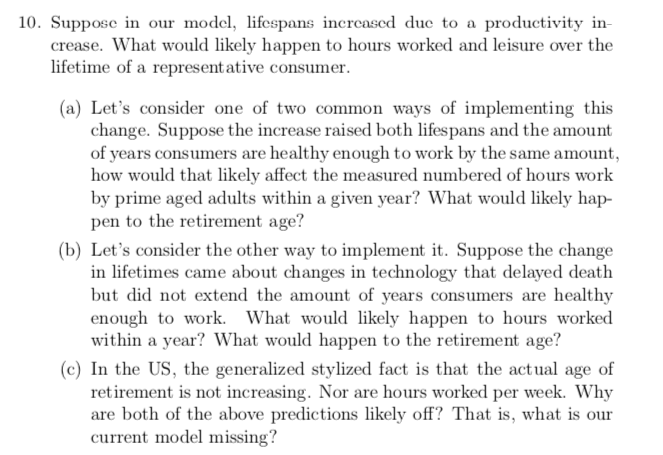
ENGR.ECONOMIC ANALYSIS
14th Edition
ISBN: 9780190931919
Author: NEWNAN
Publisher: Oxford University Press
expand_more
expand_more
format_list_bulleted
Question
thumb_up100%

Transcribed Image Text:10. Suppose in our model, lifespans increased due to a productivity in-
crease. What would likely happen to hours worked and leisure over the
lifetime of a represent ative consumer.
(a) Let's consider one of two common ways of implementing this
change. Suppose the increase raised both lifespans and the amount
of years consumers are healthy enough to work by the same amount,
how would that likely affect the measured numbered of hours work
by prime aged adults within a given year? What would likely hap-
pen to the retirement age?
(b) Let's consider the other way to implement it. Suppose the change
in lifetimes came about changes in technology that delayed death
but did not extend the amount of years consumers are healthy
enough to work. What would likely happen to hours worked
within a year? What would happen to the retirement age?
(c) In the US, the generalized stylized fact is that the actual age of
retirement is not increasing. Nor are hours worked per week. Why
are both of the above predictions likely off? That is, what is our
current model missing?
Expert Solution
This question has been solved!
Explore an expertly crafted, step-by-step solution for a thorough understanding of key concepts.
This is a popular solution
Trending nowThis is a popular solution!
Step by stepSolved in 3 steps

Knowledge Booster
Similar questions
- c pleasearrow_forwardIn a life-cycle model, a worker with constant household productivity will react to an expected decrease in wages by Select one: O A. increasing his labor supply. O B. decreasing his labor supply. O C. not changing his labor supply, since the wage increase was expected. OD. either increasing or decreasing his labor supply.arrow_forward!arrow_forward
- Then consider an individual with the exact same preferences (same indifference curve map as in the previous question) and skills, but this person happened to have a better connection with a company and is earning a higher wage than the individual in part 'a'. Thus, this person faces budget line BL' below and takes l'hours of leisure (works T - l'hours). C 50 BL l' O Keep leisure the same T Then this individual is offered the same take-it-or-leave-it (TIOLI) cash grant of $g (that must be forgone if this person works at all). What would this individual do (in terms of leisure taken (and labor supplied))? O Take no leisure 151515 O Take more leisure, but not as much at T. ولا O Take all leisure (not work at all) O None of the other options.arrow_forward10arrow_forwardASAP pls Discuss the possible substitution effect and the income effect of an increase in income on leisure time..arrow_forward
- 4. The table shows a company's yearly profit beginning in the year 2004. Time Since 2004 4. 8 10 (years) Profit (hundred thousands of dollars) 12.3 11.9 11.7 10.25 9.1 7.0 Use a quadratic regression to predict the company's profits in the 2016. year a. 469000 Ь. 705000 С. 700000 d. 674000 5. Kathy painted a picture and posted it on a social media site. The table shows the number ofarrow_forwardSuppose that a consumer cannot vary hours of work as he or she chooses. In particular, he or she must choose between working g hours and not working at all, whereg> 0. Suppose that dividend income is zero, and that the consumer pays a tax Tif he or she works, and receives a benefit b when not working, interpreted as an unemployment insurance payment. a Click the icon to view information about the initial model used here. Consumption, C W29-T w,q-T Leisure, I h-g BE a. If the wage rate increases, how does this affect the consumer's hours of work? What does this have to say about what we would observe about the behaviour of actual consumers when wages change? After the wage rate increases, an individual consumer who originally did not work at all V After the wage rate increases, an individual consumer who originally worked q hours V This suggests that if an economy includes many consumers with many different sets preferences (all satisfying the assumptions of the initial model) and the…arrow_forwardQuestion 2 Analyse the variables depicted in Figure 1 and comment on the movement of the variables over the period, using literature or other valid sources to support your answer. 0.0 26.5 25.4. 253 261 25.0 24.9 30 2.5. 20 15. 10 05 70 NO Fig. 1 Visual of the variables of study LNGOP LNIND LNTNR 10 why 9 00 05 10 15 MN.. UNFO LNCOALarrow_forward
arrow_back_ios
arrow_forward_ios
Recommended textbooks for you

 Principles of Economics (12th Edition)EconomicsISBN:9780134078779Author:Karl E. Case, Ray C. Fair, Sharon E. OsterPublisher:PEARSON
Principles of Economics (12th Edition)EconomicsISBN:9780134078779Author:Karl E. Case, Ray C. Fair, Sharon E. OsterPublisher:PEARSON Engineering Economy (17th Edition)EconomicsISBN:9780134870069Author:William G. Sullivan, Elin M. Wicks, C. Patrick KoellingPublisher:PEARSON
Engineering Economy (17th Edition)EconomicsISBN:9780134870069Author:William G. Sullivan, Elin M. Wicks, C. Patrick KoellingPublisher:PEARSON Principles of Economics (MindTap Course List)EconomicsISBN:9781305585126Author:N. Gregory MankiwPublisher:Cengage Learning
Principles of Economics (MindTap Course List)EconomicsISBN:9781305585126Author:N. Gregory MankiwPublisher:Cengage Learning Managerial Economics: A Problem Solving ApproachEconomicsISBN:9781337106665Author:Luke M. Froeb, Brian T. McCann, Michael R. Ward, Mike ShorPublisher:Cengage Learning
Managerial Economics: A Problem Solving ApproachEconomicsISBN:9781337106665Author:Luke M. Froeb, Brian T. McCann, Michael R. Ward, Mike ShorPublisher:Cengage Learning Managerial Economics & Business Strategy (Mcgraw-...EconomicsISBN:9781259290619Author:Michael Baye, Jeff PrincePublisher:McGraw-Hill Education
Managerial Economics & Business Strategy (Mcgraw-...EconomicsISBN:9781259290619Author:Michael Baye, Jeff PrincePublisher:McGraw-Hill Education


Principles of Economics (12th Edition)
Economics
ISBN:9780134078779
Author:Karl E. Case, Ray C. Fair, Sharon E. Oster
Publisher:PEARSON

Engineering Economy (17th Edition)
Economics
ISBN:9780134870069
Author:William G. Sullivan, Elin M. Wicks, C. Patrick Koelling
Publisher:PEARSON

Principles of Economics (MindTap Course List)
Economics
ISBN:9781305585126
Author:N. Gregory Mankiw
Publisher:Cengage Learning

Managerial Economics: A Problem Solving Approach
Economics
ISBN:9781337106665
Author:Luke M. Froeb, Brian T. McCann, Michael R. Ward, Mike Shor
Publisher:Cengage Learning

Managerial Economics & Business Strategy (Mcgraw-...
Economics
ISBN:9781259290619
Author:Michael Baye, Jeff Prince
Publisher:McGraw-Hill Education